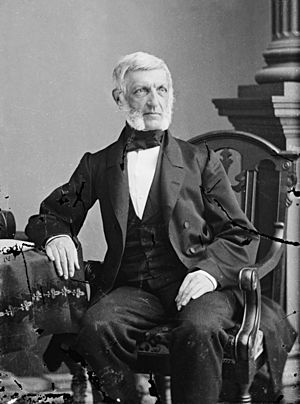Bancroft Treaties facts for kids
The Bancroft treaties were special agreements made between the United States and other countries. These agreements happened mostly in the late 1800s and early 1900s. They were about citizenship and nationality. They recognized that people from one country could become naturalized citizens of another. The treaties also explained when a person might be thought to have given up their new citizenship and gone back to their old one.
Contents
Why These Treaties Were Made
These treaties are named after George Bancroft (1800–1891). He was a historian and a diplomat. He helped create the first of these agreements with Prussia.
The main goal of the Bancroft treaties was to stop people from changing their citizenship just to avoid duties. For example, they couldn't avoid military service or other legal responsibilities in their home country.
From 1868 to 1937, the United States made 25 Bancroft treaties. These covered 34 different countries. Most treaties had three main parts:
- First, they explained how each country would recognize new citizens. Usually, a person had to live in their new country for five years without leaving.
- Second, they said that new citizens who went back to their home country could still be charged with crimes. These were crimes they might have done before they moved away.
- Third, and most important, if a new citizen stayed in their original country for two years, they were assumed to have their old nationality back. This meant they might have to do military service there. It also meant their new country might not protect them anymore.
For example, a treaty with Portugal in 1908 said:
If a Portuguese person became an American citizen, but then lived in Portugal again without planning to return to America, they would be seen as giving up their American citizenship. The same was true for an American who became a Portuguese citizen. If they lived in the United States again without planning to return to Portugal, they would be seen as giving up their Portuguese citizenship.
If someone lived in their old country for more than two years, it was assumed they did not plan to return to their new country.
Why the Treaties Became Outdated
When the Bancroft treaties were first made, it wasn't common for people to change their citizenship. These treaties were a big step forward. They helped other governments accept that their citizens could become American citizens.
However, American constitutional law eventually made these treaties less useful. The Supreme Court made some important decisions.
In 1964, in a case called Schneider v. Rusk, the Supreme Court said a law was wrong. This law would have taken away citizenship from naturalized Americans. This happened if they lived in their home country for three years.
Then, in 1967, in Afroyim v. Rusk, the Supreme Court made another big ruling. It said that Congress cannot take away anyone's citizenship. This is true whether they were born a citizen or became one later.
These decisions showed that the Bancroft treaties might not hold up in court anymore. It seemed unlikely that someone could lose their citizenship against their will because of these treaties.
Ending the Bancroft Treaties
Because the Bancroft treaties were no longer easy to enforce, the government decided to end them. In 1980, President Jimmy Carter's administration ended the treaties with 18 countries. Only treaties with Albania, Bulgaria, and Czechoslovakia remained.
The treaty with Albania ended in 1991. This was when Albania and the United States started having diplomatic relations again. The treaty with the Czech Republic and the Slovak Republic (which used to be Czechoslovakia) ended in 1997. Finally, the treaty with Bulgaria ended during President Barack Obama's time in office.
When Treaties Ended by Country
| Country | Date Signed | Year Terminated | Reason for Termination |
|---|---|---|---|
| February 22, 1868 | 1917 | Never restarted after World War I | |
| May 26, 1868 | 1871 | German Empire was formed | |
| July 4, 1868 | Ended by Mexico | ||
| July 19, 1868 | 1871 | German Empire was formed | |
| July 27, 1868 | 1871 | German Empire was formed | |
| August 1, 1868 | 1871 | German Empire was formed | |
| November 16, 1868 | 1980 | Ended by President Jimmy Carter | |
| May 26, 1869 | 1980 | Ended by President Jimmy Carter | |
| September 20, 1870 | 1917 | Never restarted after World War I | |
| February 23, 1871 | 1953 | Ended by the United Kingdom | |
| July 20, 1872 | 1980 | Ended by President Jimmy Carter | |
| March 22, 1902 | 1980 | Ended by President Jimmy Carter | |
| Pan-American Conference | August 13, 1906 | Several countries left the treaty | |
| March 14, 1908 | 1980 | Ended by President Jimmy Carter | |
| April 27, 1908 | 1951 | Ended by Brazil | |
| August 10, 1908 | 1980 | Ended by President Jimmy Carter | |
| May 7, 1908 | 1980 | Ended by President Jimmy Carter | |
| June 23, 1908 | 1980 | Ended by President Jimmy Carter | |
| October 15, 1907 | 1980 | Ended by President Jimmy Carter | |
| December 7, 1908 | 1980 | Ended by President Jimmy Carter | |
| June 10, 1911 | 1980 | Ended by President Jimmy Carter | |
| November 23, 1923 | 2017 | Ended by President Barack Obama | |
| July 16, 1928 | 1997 | Ended between Czech Republic and the Slovak Republic | |
| April 5, 1932 | 1991 | Ended when Albania and the United States restarted diplomatic relations | |
| October 18, 1937 | 1980 | Ended by President Jimmy Carter |


